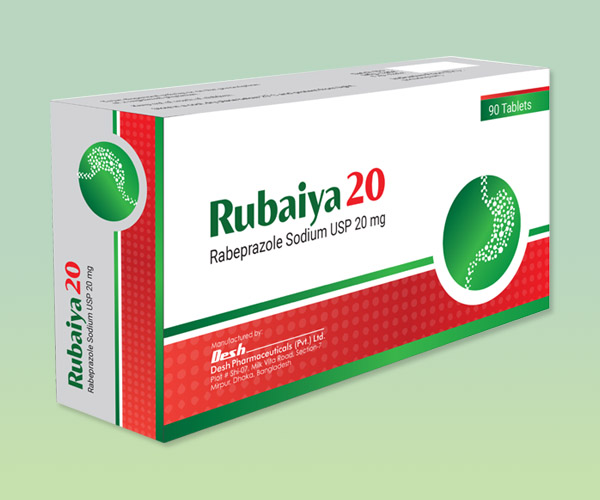Rubaiya 20 Tablet
Rabeprazole Sodium USP 20mg
Rubaiya 20 Tablet
Rabeprazole Sodium USP 20mg
Composition
Product name: Rubaiya
Strength: Rabeprazole Sodium USP 20 mg.
Dosage form: Tablet (enteric-coated)
- AVAILABILITY: AVAILABLE
Pharmacology
It is the preparation of Rabeprazole Sodium. Rabeprazole is a proton pump inhibitor.
Pharmacodynamics:
Antiulcerative action: Rabeprazole blocks activity of the acid (proton) by inhibiting gastric hydrogen-potassium adenosine triphosphatase at the secretory surface of the gastric parietal cell, blocking gastric acid secretion.
Pharmacokinetics:
Following oral administration of 20 mg, Rabeprazole is absorbed and can be detected in plasma by 1 hour. The effects of food on the absorption of Rabeprazole have not been evaluated. Rabeprazole is 96.3% bound to human plasma proteins.Rabeprazole is primarily metabolized in the liver by cytochrome P-450 3A (sulphone-metabolite) and 2C19 (desmethyl-Rabeprazole). Following a single 20 mg oral dose of 14C-labeled Rabeprazole, approximately 90% of the drug is eliminated in the urine. The remainder of the dose is recovered in the faces.
Indications
Healing of erosive or ulcerative gastro-esophageal reflux disease; Maintenance of healing of erosive or ulcerative gastro-esophageal reflux disease; benign gastric ulcer; Healing of duodenal ulcer; treatment of pathological hypersecretory conditions, including Zollinger-Elli-son Syndrome.
Dose & administration
Healing of erosive or ulcerative gastro-esophageal reflux disease (GERD): 20 mg once daily in the morning for 4-8 weeks. For those patients who have not been dealed after weeks of treatment, an additional 8 weeks course may be considered.
Maintenance of healing of erosive or ulcerative gastro-esophageal reflux disease: 20 mg once daily in the morning.
Benign gastric ulcer: 20 mg once daily in the morning for 6 weeks, followed by a further 6 weeks if not fully healed.
Healing of duodenal ulcer: 20 mg once daily in the morning for a period upto 4 weeks. A few patients may required additional therapy to achieve healing. Pathological hypersecretory conditions, including Zollinger-Ellison Syndrome: The recommended adult oral starting dose is 60 mg daily. Dose should be adjusted to individual patient needs and should be continued as long as clinically indicated. Some patients may required divided doses.
Route of administration: It should be taken orally. It must not be crushed and to be swallowed wholly.
Contraindications
It is contraindicated to known hypersensitivity to Rabeprazole, substituted benzimidazoles or any component of the formulation.
Warnings and precautions
Administration of Rabeprazole to patients with mild to moderate liver impairment resulted in increased exposure and decreased elimination. Caution should be exercised in patients with severe hepatic impairment.
Side Effects
Dry mouth, gastrointestinal disturbances (including diarrhea, nausea, vomiting, constipation, flatulence, abdominal pain), liver dysfunction, taste disturbance, hypersensitivity reactions (including rash, urticaria, angioedema, bronchospasm, anaphylaxis), peripheral edema, depression, dizziness, drowsiness, headache, insomnia, fever, hematological changes (including agranulocytosis, leucocytosis, leucopenia, pancytopenia, thrombocytopenia), intestinal nephritis, muscle and joint pain, blurred vision, photosensitivity, pruritus, severe skin reactions (including Stevens-Jhonson syndrome, toxic epidermal necrolysis, bullous eruption), sweating, malaise. Proton pump inhibitors decrease gastric acidity and may increase the risk of gastrointestinal infections, cough, pharyngitis, rhinitis, asthenia, influenza like syndrome; less commonly chest pain, sinsusitis, nervousness, rarely stomatitis, encephalopathy, in severe liver disease, anorexia, weight gain.
Use in pregnancy & lactation
There are no adequate and well controlled studies in pregnant women. This drug should be used during pregnancy only if clearly needed. A decision should be made to discontinue nursing or discontinue the drug, taking into account the importance of the drug to the mother.
Use in children & adolescents:
The safety and effectiveness of Rabeprazole in pediatric patients have not been established.
Drug interactions
Rabeprazole is metabolized by the cytochrome P-450 (CYP 450) drug metabolizing enzyme system. Rabeprazole dose not have clinically significant interactions with other drugs metabolized by the CYP450 system, such as warfarin and theophylline given as single oral dose, diazepam as a single intravenous dose, and phenytoin given as a singles intravenous dose. In normal subjects, co-administration of Rabeprazole 20 mg QD resulted in an approximately 30% decrease in the bioavailability of ketoconazole and increase in the AUC and Cmax for digoxin of 90% and 29% respectively.
Food does not affect the amount of Rabeprazole that enters the body, but it does delay its onset of effect by about 1.7 hours.
Overdose
There has been no experience with large overdoses with Rabeprazole. No specifice antidote for Rabeprazole is known. Rabeprazole is extensively protein bound and is not readily dialyzable. In the event of overdosage, treatment should be symptomatic and supportive.
Storage
Store in a cool, dry place below 25C and protect from light. Keep out of reach of children.
Packaging
Rubaiya-20 Tablet: Box containing 3×10 / 5×10 / 6×15 tablets in blister pack. Each blister cutting is packed with aluminum sachet.
